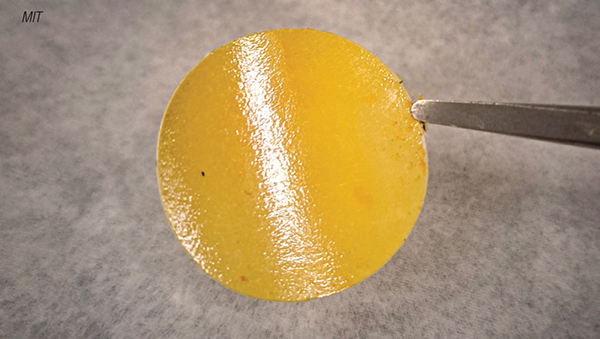Thin-film polymer membranes have been very effective for industrial-scale desalination of seawater, but have not been used for separation of liquid hydrocarbon mixtures because oil-separation membranes tend to absorb oil components and swell, which eliminates their size-sieving ability to separate heavy and light hydrocarbon compounds. Now, a team of researchers at the Massachusetts Institute of Technology (MIT; Cambridge, Mass.; www.mit.edu) has developed a polymer membrane (photo) that can overcome several of these shortcomings.

To make the new membrane polymer, the MIT team modified a technique used previously to synthesize desalination membranes. Known as interfacial polymerization, the technique sets up a phase barrier between an aqueous layer, in which one monomer is dissolved, and an organic layer, where an oil-soluble monomer is dissolved. When used for desalination membranes, a thin film with polyamide linkages forms at the interface. For the new hydrocarbon-separation polymer, the MIT scientists had to make a number of important modifications.
“Previous research on hydrocarbon separation membranes has focused on a class of materials called ‘polymers of intrinsic microporosity (PIMs),’ which tend to swell when exposed to non-polar molecules,” explains MIT post-doctoral researcher Taehoon Lee, the lead author of the study, published recently in Science, who is now a professor at Sungkyunkwan University (SKKU) in Seoul, South Korea. “Polymer cross-linking can help with swelling, but there’s a tradeoff in which cross-linking causes the microstructure to densify, prohibiting selective passage of hydrocarbons,” Lee says.
This challenge led the team to alternative polymer linkages — they ended up using imine bonds (C=N double bonds), which are more rigid and less polar than polyamides. This approach prevents much of the swelling that occurs with hydrocarbon-separation membranes.
Aside from synthesizing the polymer with imines, the MIT researchers also used specially selected monomers that are capable of generating microporosity that is shape-persistent for the separation of hydrocarbons. The team used monomers called triptycene and spirobifluorene, which help the polyimines form pores with the correct size and geometry to pass hydrocarbons of certain molecular weights (size) through.
With further development, the MIT team envisions potential applications for the membrane in crude- and biocrude-oil fractionation, as well as niche applications like purifying solvents for semiconductor manufacturing and drug development.
“Distillation separates crude oil very well, but requires large amounts of energy,” says MIT chemical engineering professor Zachary P. Smith, the senior author of the study. “So the vision would be if crude oil could be fractionated effectively with stable and long-lasting membranes in a high-throughput continuous process, there would be enormous energy savings — potentially several tens of percent — similar to those already achieved in the desalination industry.”